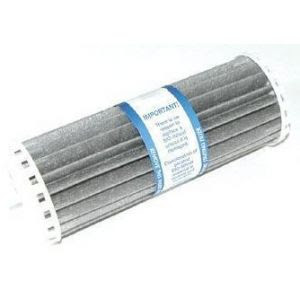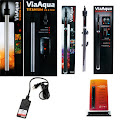Our Facebook Page to Follow: Aquarium/Pond Answers Facebook
This is a unique resource for answers, help, & advice to aquarium and pond questions not found elsewhere; With regular posts & article updates.
In our research; we use aquaculture, horticulture, medical, & university research to compile many of our articles.Our Recommended Lighting for highest efficiency professional planted/reef aquariums: "AquaRay Lighting"
Do Bio Wheels really work? Bio-Wheel Review
By Carl Strohmeyer-PAMR 40+ years experience
QUESTION: Do Bio Wheels really work? Bio Wheel Review & Controlled Tests
Updated 6/3/19
A Little Background
There is a lot of information about bio wheels and their importance in bio filtration in aquariums. In theory Bio Wheels are a great idea and admittedly I bought into this idea for years without testing the results to see if the hype was true.
In theory the wheel turns into the air where the oxygen that aerobic bacteria need to remove ammonia and nitrites is much more abundant than in water. Unfortunately oxygen is not the only requirement for nitrifying bio bacteria; you also need usable surface area. Bio wheels generally do not have as much useable surface area as other aerobic bacteria bio surfaces such as Sponge media or suspended (fluidized) sand media. You also need nutrients, and often the bacteria in bio wheels are not exposed to enough nutrients.
It is also noteworthy that a dissolved oxygen level of 5-7 ppm that a properly circulated/aerated aquarium should have, is ample oxygen for nitrifying bacteria.
Later, after many bio-wheels stalled and I was challenged by another knowledgeable person in the maintenance business to test them against other filters rather than rely on my anecdotal observations (he had performed such tests and knew the answer). I then decided to start testing these bio-wheels versus other bio filter methods.
ADVERTISEMENT
Tests, Further Information
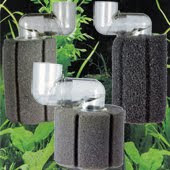 In my first and more limited test (this is the test my colleague had performed), I removed the bio wheel penguin filters on comparable (60 gallon) established aquariums with comparable bio loads and fish and found no discernible ammonia spike.
In my first and more limited test (this is the test my colleague had performed), I removed the bio wheel penguin filters on comparable (60 gallon) established aquariums with comparable bio loads and fish and found no discernible ammonia spike.
YET when HOB filters that had running AAP Sponge Pre Filters attached to their intakes were removed, there were discernible ammonia spikes. What this means is that the working Bio Wheel was NOT the primary source or even an important source of bio filtration for the tanks with the bio wheels.
In other words these tanks were maintaining whatever bio filtration they had via other means such as gravel, filter cartridges, etc, while the aquariums with the Pre-Filters (& a couple with a sponge insert) had these bio filter mediums removed, the subsequent loss of bio filtration via a discernible spike in ammonia/nitrites was noted.
A resource for:
Filter Max Aquarium Pre Filters
 The second test involved many more aquariums and was more extensive.
The second test involved many more aquariums and was more extensive.
This second test consisted of 60 & 80 gallon aquariums (performed at my large client; Coaster Co of America which had over 20 aquariums).
Goldfish and Discus aquariums were utilized, all WELL established, with the same bio load and feeding regimen.
In fact the same aquariums were re-used multiple times in this second test as I would change out filters and then wait 8 weeks prior to re-testing with a different filter (this second test went on over a 9 month span).
In these, I ran some tests with Penguin Filters (as well as Emperor Filters) with Bio Wheels against Sponge Filters, Aqua Clears and Whisper Filters with the Sponge inserts in equal established tanks fed the same amount, then added large amounts of fish food and although the bio wheels did respond, the Sponge Filter showed a lowest ammonia spike of any filter tested when only one filter was present.
What is also noteworthy is I also used Tetra, Lees, Hagen Elite, and Chinese no name knock off Sponge filters in this test and NONE of these performed to the level of the patented AAP Hydro Sponge Filters. Part of the reason is the unique flow design, but more so to the patented sponges themselves that had more pores and did not clog as quickly as others.
A resource for:
Hydro Sponge Aquarium Filters by AAP
Another result emerged, and that is in these tests the aquariums that responded to the largest amounts of fish food being added, were the multi-filter tanks that included a HOB Filter (such as a Whisper, SunSun Power Filter, etc.) AND a Sponge Filter which provided a good example of how much Sponge Filtration via a simple Sponge Filter can improve aquarium bio capacity.
Reference:
*How sponge filters work and the benefits of using sponge filters in aquariums and ponds
These tests also included removal and/or replacement of cartridges in HOB Filters that had both cartridges and a secondary Bio Sponge, Grid, etc. such as the Whisper, SunSun etc. and of course the cartridge in the Marineland Penguin & Emperors.
Again, the Bio Wheel in most instances did not match these other filters EXCEPT in the case of power filters (of which there are many) that only had a cartridge; in the tests with these "cartridge only" filters the Bio wheel filter considerably out performed these rather basic power filters.
It is noteworthy that although the cartridge only filters were not as effective as the Bio Wheel Filters due to the fact that most bio colonies were removed with each change of the cartridge; HOWEVER when a Sponge Pre-Filter was added to these 'cartridge only' filters (such as a "Cheapie" Walmart filter used in this test), the HOB Filters with the Sponge Pre-Filter (an AAP Filter Max Pre-filter) again outperformed the Bio Wheel Filter (a Penguin in this test).
A resource for:
Filter Max Pre-Filters by AAP
Both these tests were not performed under the 100% scientific scrutiny (although the second was much more extensive and gave a better picture of nitrifying bacterial colonies), however they certainly gave an interesting snapshot of the effectiveness of different bio filtration types.
Reference:
The Aquarium Nitrogen Cycle; Bacterial Colonies
I might add that since these initial tests/studies several years ago, Fluidized Filters have emerged as THE superior aerobic bio filter (especially the newest models sold by AAP).
A resource for Fluidized Filters:
AAP Fluidized High Performance Bio Aquarium Filter
Tests I ran with Sponge Filters versus 2nd generation Fluidized Sand Bed Filters showed that even the Sponge Filters (the #5 Hydro Sponge versus the basic Lifeguard FB Filter) could not respond to increasingly higher "dumps" of fish food as fast as the FB Filters could.
As well a new variation on the HOB filter has also emerged that combines the Wet/Dry, Sponge and HOB filter with many of the attributes of these three before mentioned filters and that is the Internal Wet/Dry such as the ReSun BF 100 or the filter found in Bio Cube Aquariums. These are in many ways similar to a large Aqua Clear filter, except with the ability to add external devices such as a UV Sterilizer.
My reason in pointing out these filters is that there are even newer more effective alternatives to Bio Wheels currently available that are not expensive either.
 This is not to say a bio wheel does not work at all, especially if there is less build up deposits on the bio wheel fiber.
This is not to say a bio wheel does not work at all, especially if there is less build up deposits on the bio wheel fiber.
What is much more important is to have an adequate amount of dissolved oxygen through agitation of the water surface, which is where oxygen and other gasses are exchanged from the atmosphere and the aquarium. I have found a porous sponge filter media to maintain more bacteria in well oxygenated water.
This is an important point as although air can contain much more oxygen necessary for aerobic nitrifying bacteria (which is the theory behind bio wheels), the fact remains that the nitrifying bacteria do quite well at the normal dissolved oxygen level of 5-7 ppm of most adequately circulated and properly stocked aquariums.
In fact a somewhat unknown filter; the Fluidized Filter will out performed bio wheels and wet/dry filters, even Sponge Filters in later tests and yet these are "sealed" filters, which further blows the argument for Bio Wheels out of the water that states the oxygen availability of the wet/dry feature of the bio-wheel is superior for bio filtration (this comparison is based on established filters over 6 months old).
Here are a few reasons behind the poor results of bio wheels:
- Hard water buildup; although not as much a problem in soft water aquariums, this is a major problem with hard water aquariums and especially marine aquariums (where these bio wheels are a total waste of money).
What happens is the calcium, salts and other deposits form in the pores of the bio wheel fiber, not allowing bacteria to form there. This is the main reason for the lack of effectiveness for bio wheels.
My tests in Discus aquariums (which are soft water) showed better results for bio wheels (although not as well as sponge or other porous media). - Lack of surface area; a bio wheel does not have the surface of many other bio media products from sponge media to the very porous pumice and ceramic media used by Eheim and others.
Previously mentioned deposits further degrade the surface area. This is not to say that other filter media do not develop deposits that resist bacterial colonization, however the in/out of water nature of a bio-wheel lends itself to a much higher rate of deposits which a simply magnifying glass inspection will reveal - Unlike a sponge filter, especially the patented AAP/ATI Hydro Sponge Filters, the Bio Wheels have no capacity for trapping nitrogenous waste that can then be easily removed via a rinsing or similar maintenance procedure.
- Bio wheels run in a high oxygen environment that encourages fast aerobic nitrifcation, but little else. This allows for copious amounts of nitrates to be generated in a short amount of time.
This type of environment does not keep a stable bacterial colony to respond to sudden changes in bio load either.
With this environment, there is also no chance for a de-nitrifying environment to establish in filters that employ bio wheels.
It is noteworthy that these negative attributes are multiplied in the Emperor HOB Filter with spray bars running the bio wheels. - Bio wheel stalls; bio wheels have a bad habit of stalling or rotating too slowly for the bacteria to be bathed in nutrients. This can be only a minor reason to not have these bio wheels as this is a somewhat correctable problem.
Here is a way correct this problem (this will be an on going maintenance problem).
Make sure the Teflon ends on the bio wheel axle are clean and have no build ups of calcium you can replace these with Teflon tape in a pinch.
Also make sure the bio wheel assembly is not to tight, simply remove the bio wheel and gently stretch the assembly apart so the wheel can spin more freely. - As for the Marineland Emperor Bio Wheel Filter, I have heard some unsupported arguments for this filter, HOWEVER in multiple observations where the Emperor Filter was replaced with a Hydro Sponge #5 (& smaller) (see resource earlier in the article) or another filter along with the use of SeaChem Matrix, tank conditions improved for many parameters, most notably KH, nitrates and Redox.
WHY one might ask? This is where this observation can be answered with known science and that is the design of the Emperor filter lends itself to being a nitrate factory with its spray bar and irrigation of the basket area, not allowing the use of products such as SeaChem Matrix, de-Nitrate, volcanic rock, Bio Home, live rock crumbles, etc.
I have also found decomposition that leads to decay of KH and reduced Redox balance with Emperor Filters.
Reference:
Importance of Aquarium Redox
I will also note that I have found similar results with poor Redox, KH, nitrates with the use of wet/dry filters systems that employ bio balls and/or ceramic media (not so with Wet/Dry employing live rock and/or sponge filters).
SUMMARY;
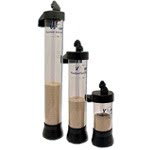 This is NOT to say bio wheels do not work, they are certainly better than cartridge only filters! Bio wheels just do not hold up to the hype and urban myths about them in the aquarium hobby.
This is NOT to say bio wheels do not work, they are certainly better than cartridge only filters! Bio wheels just do not hold up to the hype and urban myths about them in the aquarium hobby.
You can often do better with the sponge in an Aqua Clear, AAP/SunSun, AAP Tidal, or Whisper Filter, or a sponge pre filter on ANY HOB filter (AAP Filter Max), and especially a separate Sponge Filter and even more so a Fluidized Filter (which the Bio Wheel filters do not even come close to in bio capacity), even an aquarium sponge stuck inside a HOB filter without any other bio media.
I have used many Bio Wheel (Penguin, Emperor, etc.) filters over the years with good results, my point is again not that they do not work, just if you are purchasing one of these filters for the main reason of having a “better” bio filter, you are not making the best choice based on controlled test data.
HOB Filter Resources:
*AAP/SunSun Effective economy Aquarium Power Filter
*AAP/SeaChem Tidal Premium HOB Filter
I also want to be clear that if you already have a Bio Wheel equipped Penguin or Emperor that I am NOT advocating that you immediately trash this filter and run down to your local fish store (or online) to purchase a new filter, rather to consider their drawbacks and I do STRONGLY recommend the purchase of a filter such a Hydro Sponge Filter, Internal Wet/Dry Filter, or Fluidized Filter (the Fluidized filter requires a power head or canister filter to power it) to compliment your Bio Wheel equipped filter.
This is what I recommend for any filtration system anyway; the redundancy of more than one filter!
Finally, what is missed by proponents of Bio-wheels is although the oxygen aspect of the bio-wheel is one aspect of aerobic nitrification, it is not difficult to maintain adequate oxygen levels for most other aquarium bio filters in a properly set up tank.
What is more important is surface area and there are many other specific filter medias with vastly superior surface area such as nitrifying and de-nitrifying volcanic rock, Matrix, ceramic media and MUCH more.
High Surface Area Filter Media:
*Volcanic Rock
*SeaChem Matrix Aerobic and Anaerobic Bio Media
*Nirox Bio Pure Ceramic Bio Rings
Another important aspect of aerobic filtration is that the faster and more ammonia and nitrites your aquarium bio filter processes the more nitrates your aquarium will have in the end. This is especially noteworthy for marine aquariums which is why I would recommend live rock crumbles, volcanic rock, Matrix or similar filter media that has deep pores to perform de-nitrification via anaerobic bacteria and why my consideration many years back of a large bio wheel system for a marine tank was/is a bad one.
The use of a Protein Skimmer in Marine tanks can be helpful in preventing nitrate buildup as well.
Resource for Protein Skimmer: Marine Protein Skimmers
Please see this excellent article for more marine aquarium information:
“Saltwater Basics to Advanced”
More about: Aquarium Nitrates
I will also state that the design of most Marineland (Penguin, Emperor Filters) are very efficient and they are reliable mechanical filters with much less flow-by than some others, most notably Aqua Clears, so with this in mind, ANY filter decision should be based on what you need out of a filter.
For more aquarium information about aquarium filters:
How Aquarium Filters work, Different Types
Other Suggested Resources, Products, Videos
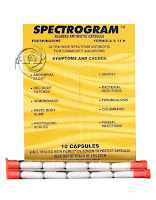
The most effective medication BAR NONE for the treatment of Columnaris in an aquarium when used as part of the four step program of Columnaris treatment.
A more synergistic combination than purchasing Kanamycin & Nitrofurazone separately.
AAP Spectrogram; Synergistic Kanamycin/Nitrofurazone

YouTube; How to: 4 Steps Columnaris Treatment Fish Bacterial Infection
This video goes over the basics of the full four step plan of properly treating Columnaris in aquarium fish and is a compliment to a FULL reading of this article.

Aquarium Lighting; Planted, Reef, more
The most complete article about the subject of determining the best lights for your reef, planted or just fish aquarium

UV Sterilization, Sterilizer Use

NilocG Aquatics; Planted Tank Liquid Ferts
NilocG Aquatics PROFESSIONAL GRADE planted aquarium liquid fertilizer products.
Products designed for persons who want to have a more advanced planted aquarium without the hassles need for a degree in science to do so. Meant for use in "The Estimative Index of Dosing, or No Need for Test Kits" method of planted aquarium aquascaping.

AAP/SunSun HJ-1542; replaces Via Aqua 1300
This pump replaces the Via Aqua 1300 and other copies such as by AquaTop as the Premier Power Head Pump for Aquariums, Ponds, Fountains, Wet/Dry Filters. This pump is submersible with Mag drive & ceramic shaft
The best in Quartz, Under gravel, and Submersible Heaters:
Fish as Pets; Parasite Retailers
Celestial Pearl Danio, Galaxy Rasboras
ADVERTISEMENT
Labels: Aquarium Bio Wheel, Bio Wheel Review, Sponge Filter

